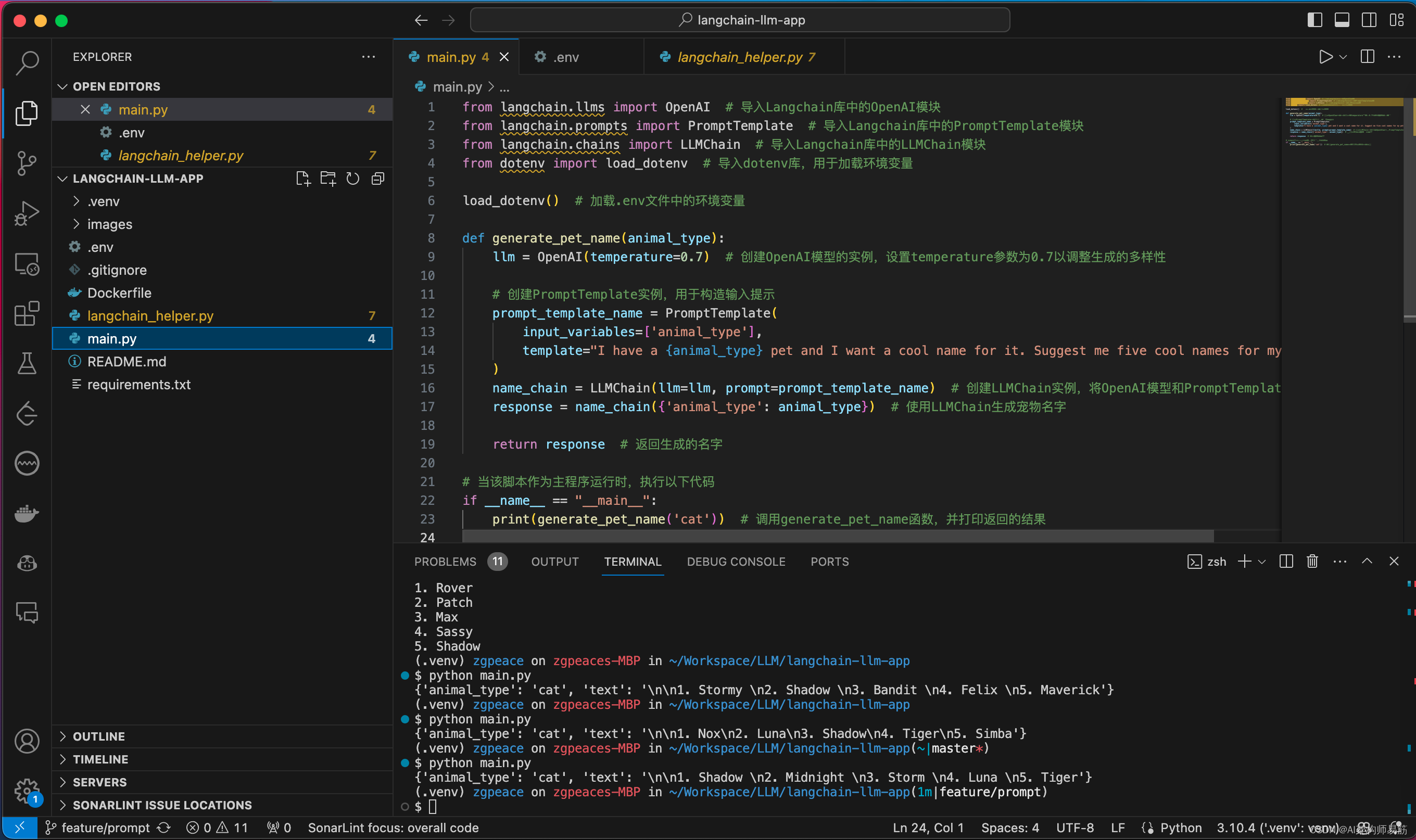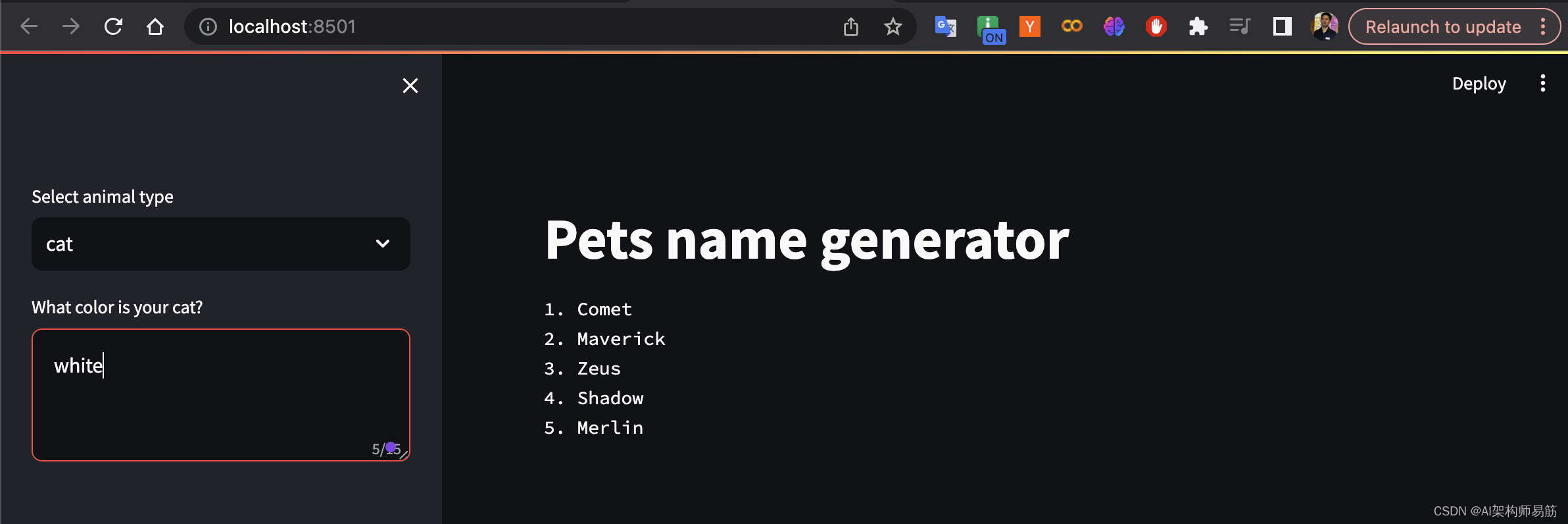LangChain 2模块化prompt template并用streamlit生成网站 实现给动物取名字
上一节实现了 LangChain 实现给动物取名字,
实际上每次给不同的动物取名字,还得修改源代码,这周就用模块化template来实现。
1. 添加promptTemplate
from langchain.llms import OpenAI # 导入Langchain库中的OpenAI模块
from langchain.prompts import PromptTemplate # 导入Langchain库中的PromptTemplate模块
from langchain.chains import LLMChain # 导入Langchain库中的LLMChain模块
from dotenv import load_dotenv # 导入dotenv库,用于加载环境变量
load_dotenv() # 加载.env文件中的环境变量
def generate_pet_name(animal_type):
llm = OpenAI(temperature=0.7) # 创建OpenAI模型的实例,设置temperature参数为0.7以调整生成的多样性
# 创建PromptTemplate实例,用于构造输入提示
prompt_template_name = PromptTemplate(
input_variables=['animal_type'],
template="I have a {animal_type} pet and I want a cool name for it. Suggest me five cool names for my pet."
)
name_chain = LLMChain(llm=llm, prompt=prompt_template_name) # 创建LLMChain实例,将OpenAI模型和PromptTemplate传入
response = name_chain({'animal_type': animal_type}) # 使用LLMChain生成宠物名字
return response # 返回生成的名字
# 当该脚本作为主程序运行时,执行以下代码
if __name__ == "__main__":
print(generate_pet_name('cat')) # 调用generate_pet_name函数,并打印返回的结果
运行和输出
$ python main.py
{'animal_type': 'cat', 'text': '\n\n1. Shadow \n2. Midnight \n3. Storm \n4. Luna \n5. Tiger'}
(.venv) zgpeace on zgpeaces-MBP in ~/Workspace/LLM/langchain-llm-app(1m|feature/prompt)
$ python main.py
{'animal_type': 'cow', 'text': '\n\n1. Milky\n2. Mooly\n3. Bessie\n4. Daisy\n5. Buttercup'}
(.venv) zgpeace on zgpeaces-MBP in ~/Workspace/LLM/langchain-llm-app(4m|feature/prompt*)

2. 添加新的参数pte_color
from langchain.llms import OpenAI # 导入Langchain库中的OpenAI模块
from langchain.prompts import PromptTemplate # 导入Langchain库中的PromptTemplate模块
from langchain.chains import LLMChain # 导入Langchain库中的LLMChain模块
from dotenv import load_dotenv # 导入dotenv库,用于加载环境变量
load_dotenv() # 加载.env文件中的环境变量
def generate_pet_name(animal_type, pet_color):
llm = OpenAI(temperature=0.7) # 创建OpenAI模型的实例,设置temperature参数为0.7以调整生成的多样性
# 创建PromptTemplate实例,用于构造输入提示
prompt_template_name = PromptTemplate(
input_variables=['animal_type', 'pet_color'],
template="I have a {animal_type} pet and I want a cool name for it. Suggest me five cool names for my pet."
)
name_chain = LLMChain(llm=llm, prompt=prompt_template_name) # 创建LLMChain实例,将OpenAI模型和PromptTemplate传入
response = name_chain({'animal_type': animal_type, 'pet_color': pet_color}) # 使用LLMChain生成宠物名字
return response # 返回生成的名字
# 当该脚本作为主程序运行时,执行以下代码
if __name__ == "__main__":
print(generate_pet_name('cow', 'black')) # 调用generate_pet_name函数,并打印返回的结果
运行结果
$ python main.py
{'animal_type': 'cow', 'pet_color': 'black', 'text': '\n\n1. Daisy\n2. Maverick\n3. Barnaby\n4. Bessie\n5. Bossy'}
(.venv) zgpeace on zgpeaces-MBP in ~/Workspace/LLM/langchain-llm-app(6m|feature/prompt*)
3. 重构代码
把逻辑放到langchain_helper.py, 清空main.py代码
4. 用Streamlit 生成网页
main.py 代码实现
import langchain_helper as lch
import streamlit as st
st.title("Pets name generator")
add path environment in .zshrc
export PATH="/Library/Frameworks/Python.framework/Versions/3.10/bin:$PATH"
source .zshrc
zgpeaces-MBP at ~/Workspace/LLM/langchain-llm-app ±(feature/prompt) ✗ ❯ streamlit run main.py
👋 Welcome to Streamlit!
If you’d like to receive helpful onboarding emails, news, offers, promotions,
and the occasional swag, please enter your email address below. Otherwise,
leave this field blank.
Email:
You can find our privacy policy at https://streamlit.io/privacy-policy
Summary:
- This open source library collects usage statistics.
- We cannot see and do not store information contained inside Streamlit apps,
such as text, charts, images, etc.
- Telemetry data is stored in servers in the United States.
- If you'd like to opt out, add the following to ~/.streamlit/config.toml,
creating that file if necessary:
[browser]
gatherUsageStats = false
You can now view your Streamlit app in your browser.
Local URL: http://localhost:8501
Network URL: http://192.168.50.10:8501
For better performance, install the Watchdog module:
$ xcode-select --install
$ pip install watchdog
http://localhost:8501/

5. Streamlit 生成网页输入跟Langchain互动获取名字
main.py
import langchain_helper as lch # 导入名为langchain_helper的模块,并使用别名lch
import streamlit as st # 导入Streamlit库,并使用别名st
st.title("Pets name generator") # 在Streamlit应用中设置标题
# 通过侧边栏选择宠物类型
animal_type = st.sidebar.selectbox("Select animal type", ["dog", "cat", "cow", "horse", "pig", "sheep"])
# 根据宠物类型设置宠物颜色,使用侧边栏的文本区域输入
if animal_type in ['dog', 'cat', 'cow', 'horse', 'pig', 'sheep']:
pet_color = st.sidebar.text_area(label=f"What color is your {animal_type}?", max_chars=15)
else:
pet_color = st.sidebar.text_area(label="What color is your pet?", max_chars=15)
# 如果有输入颜色,调用generate_pet_name函数生成宠物名字并显示
if pet_color:
response = lch.generate_pet_name(animal_type, pet_color)
st.text(response['pet_name'])
langchain_hepler.py 实现
from langchain.llms import OpenAI # 导入Langchain库中的OpenAI模块
from langchain.prompts import PromptTemplate # 导入Langchain库中的PromptTemplate模块
from langchain.chains import LLMChain # 导入Langchain库中的LLMChain模块
from dotenv import load_dotenv # 导入dotenv库,用于加载环境变量
load_dotenv() # 加载.env文件中的环境变量
def generate_pet_name(animal_type, pet_color):
llm = OpenAI(temperature=0.7) # 创建OpenAI模型的实例,设置temperature参数为0.7以调整生成的多样性
# 创建PromptTemplate实例,用于构造输入提示
prompt_template_name = PromptTemplate(
input_variables=['animal_type', 'pet_color'],
template="I have a {animal_type} pet and I want a cool name for it. Suggest me five cool names for my pet."
)
name_chain = LLMChain(llm=llm, prompt=prompt_template_name, output_key='pet_name') # 创建LLMChain实例,将OpenAI模型和PromptTemplate传入
response = name_chain({'animal_type': animal_type, 'pet_color': pet_color}) # 使用LLMChain生成宠物名字
return response # 返回生成的名字
# 当该脚本作为主程序运行时,执行以下代码
if __name__ == "__main__":
print(generate_pet_name('cow', 'black')) # 调用generate_pet_name函数,并打印返回的结果

参考
- https://github.com/zgpeace/pets-name-langchain/tree/feature/prompt
- https://youtu.be/lG7Uxts9SXs?si=H1CISGkoYiKRSF5V
- Streamlit - https://streamlit.io
